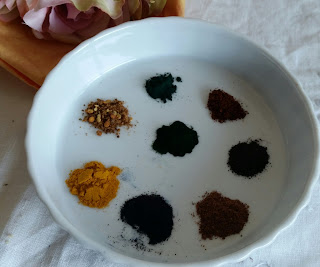 |
Left to Right: Powdered Strawberry, Indigo, Alkanet and Brazilian Purple Clay,
Alkanet, Cocoa Powder |
These are the results of my experiment on the weekend using natural ingredients to colour my cold processed soap.
My soap batter was made up of the following base oils. Olive Oil, Coconut Oil, Rice Bran Oil & Cocoa Butter.
Into 500 ml of batter I added:
1. 2 tsp of Strawberry Powder - Initially there was a faint smell of strawberry. Four days later, there is no indication of the smell of strawberries, and the soap has turned a light tan colour.
2. 4 tsp of infused Indigo - Initially, there was a pale blue tint to the soap. However, after four days, the soap appears white. I don't think this will deepen in colour but will check back in a week. Most likely, I will need to increase the quantity of infused oil.
3. 1 tsp Brazilian Purple Clay mixed with 2 tsp Infused Alkanet - I'm really loving this colour and I'm hoping this won't deepen too much.
4. 2 tsp Alkanet - Initially there was a very pale pink tinge to the soap but it seems I have completely missed the mark and used too little Alkanet infusion. At the moment, I can't see any colour tint to this soap. Back to the drawing boards for this one :-(
5. 2 tsp Cocoa Powder - This is a nice brown colour to the soap. This one I think will darken over the next few days as it is exposed to the air.
Even though some of the colours haven't turned out how I thought they would, I am really happy with the colours produced and how creamy and complimentary they look all lined up together.











